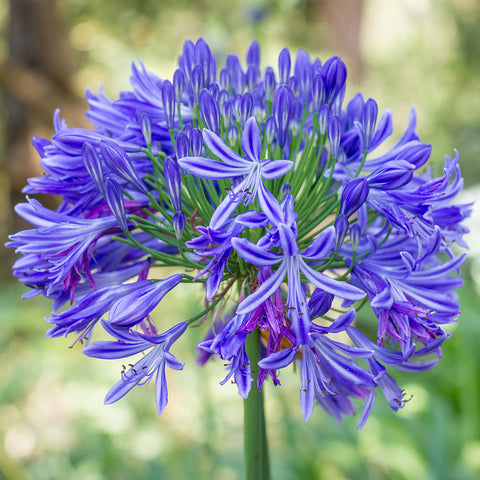Agapanthus Propagation: Tips for Expanding Your Plant Collection
Agapanthus Propagation: Tips for Expanding Your Plant Collection
Blog Article
Grasping the Art of Agapanthus Treatment: Important Actions for Healthy And Balanced Development and Vibrant Flowers
In the world of gardening, the growing of agapanthus stands as a gratifying endeavor for those that seek to support these sophisticated flowering plants. From selecting the appropriate variety to mastering trimming methods, the journey towards growing growing agapanthus plants is diverse and holds the essential to unlocking the complete capacity of these herb gems.

Selecting the Right Agapanthus Range

When selecting the right Agapanthus selection for your garden, take into consideration aspects such as climate suitability, blossom shade, and development practice. Additionally, think about the environment in your area to ensure the Agapanthus range you select can prosper in your details problems. Comprehending the growth habit of various Agapanthus selections is vital for appropriate placement within your yard.
Suitable Planting Problems
Thinking about the optimum ecological requirements is essential for effective Agapanthus growing. Agapanthus thrives in well-draining dirt with a slightly acidic to neutral pH degree. When planting, choose a location that obtains complete sunlight to partial color. In hotter environments, supplying some afternoon color can avoid scorching of the fallen leaves. Agapanthus plants are sensitive to cool temperature levels and should be shielded from frost during cold weather.
To make certain healthy growth and dynamic blossoms, plant Agapanthus light bulbs at a depth of regarding 2-4 inches and room them 8-12 inches apart. Adding raw material, such as garden compost, to the dirt can improve drainage and fertility, advertising durable root advancement. Mulching around the base of the plants assists keep moisture and subdues weed growth. Normal watering is critical, especially during the growing season, to maintain the dirt regularly damp yet not waterlogged.
Watering and Fertilizing Tips
Preserving appropriate wetness levels and supplying essential nutrients are crucial components in the care regimen for Agapanthus plants. When it involves sprinkling Agapanthus, it is critical to strike an equilibrium. These plants favor consistently moist soil but are at risk to root rot if overwatered. During the expanding period, water deeply once a week, ensuring the dirt is well-draining to avoid waterlogging. In hotter climates or during periods of dry spell, even more regular watering may be necessary to keep the dirt uniformly damp. Nonetheless, lower watering in the winter season to avoid waterlogged problems.
Feeding Agapanthus is necessary for promoting healthy and balanced development and prolific blossoms. Apply a well balanced plant food, such as a 10-10-10 formula, in the early spring as brand-new growth arises. Repeat this application every 6-8 weeks throughout the growing period. Avoid extreme fertilization, as it can cause rich foliage at the cost of blooms. Always comply with the supplier's instructions for appropriate dilution and application methods. By complying with these watering and feeding pointers, you can guarantee your Agapanthus plants grow and produce vibrant, resilient blooms.
Trimming Techniques for Agapanthus
Trimming Agapanthus plants at the appropriate times and with proper techniques is vital click to read more for keeping their wellness and promoting optimal growth and flowering. The optimal time to prune Agapanthus is in late wintertime or very early springtime before new growth emerges.
Deadheading invested flowers can also reroute the plant's power into producing even more flowers rather than establishing seeds. If you desire to gather seeds for propagation, leave some blossoms to completely dry and mature on the plant.
Keep in mind to use clean, sharp tools to make exact cuts and reduce the risk of presenting illness. Agapanthus. Routine trimming will certainly help find more information maintain your Agapanthus looking cool and healthy while making certain a plentiful screen of gorgeous flowers
Handling Usual Pests and Conditions
After ensuring proper trimming methods for Agapanthus, it is crucial to deal with typical parasites and diseases that can affect the wellness and vigor of these plants. One common bug that influences Agapanthus is the Agapanthus gall midge.
Furthermore, Agapanthus plants can endure from root rot if they are planted in poorly draining pipes soil. By being alert and taking punctual activity versus diseases and insects, you can help your Agapanthus plants flourish and produce lively blossoms. Agapanthus.

Final Thought
Finally, understanding the art of agapanthus treatment involves choosing the appropriate selection, giving excellent planting problems, appropriate watering and fertilizing, suitable pruning strategies, and attending to common pests and illness. By complying with these crucial actions, you can guarantee healthy growth and vibrant flowers for your agapanthus plants. Keep in mind to routinely monitor and preserve your plants to promote their general well-being and long life.
To make sure healthy development original site and lively flowers, plant Agapanthus light bulbs at a depth of regarding 2-4 inches and space them 8-12 inches apart. By adhering to these watering and fertilizing tips, you can guarantee your Agapanthus plants thrive and produce lively, long-lasting flowers.
One common parasite that affects Agapanthus is the Agapanthus gall midge. Furthermore, Agapanthus plants can suffer from root rot if they are planted in inadequately draining dirt. By following these crucial steps, you can make certain healthy development and vibrant blooms for your agapanthus plants.
Report this page